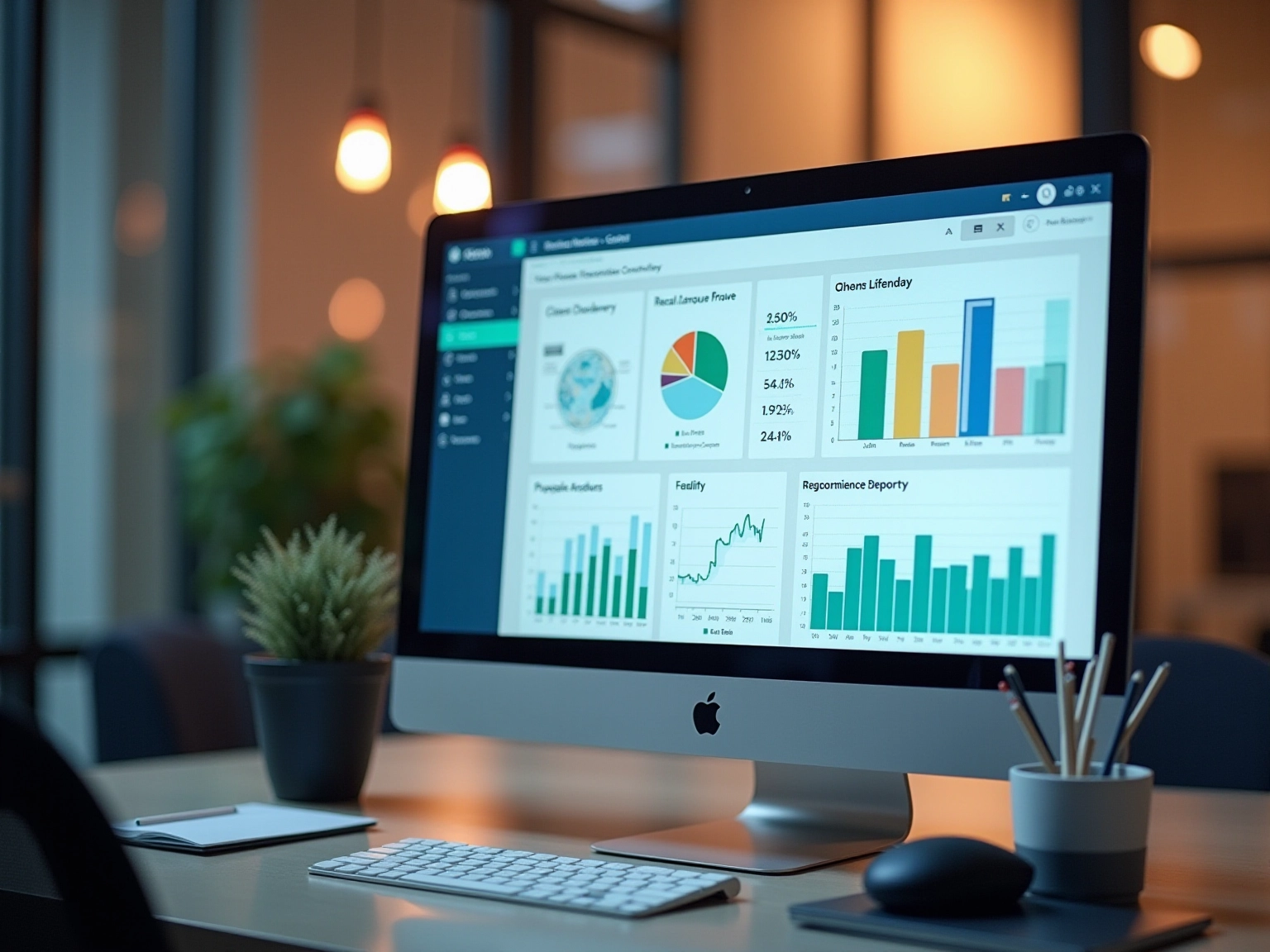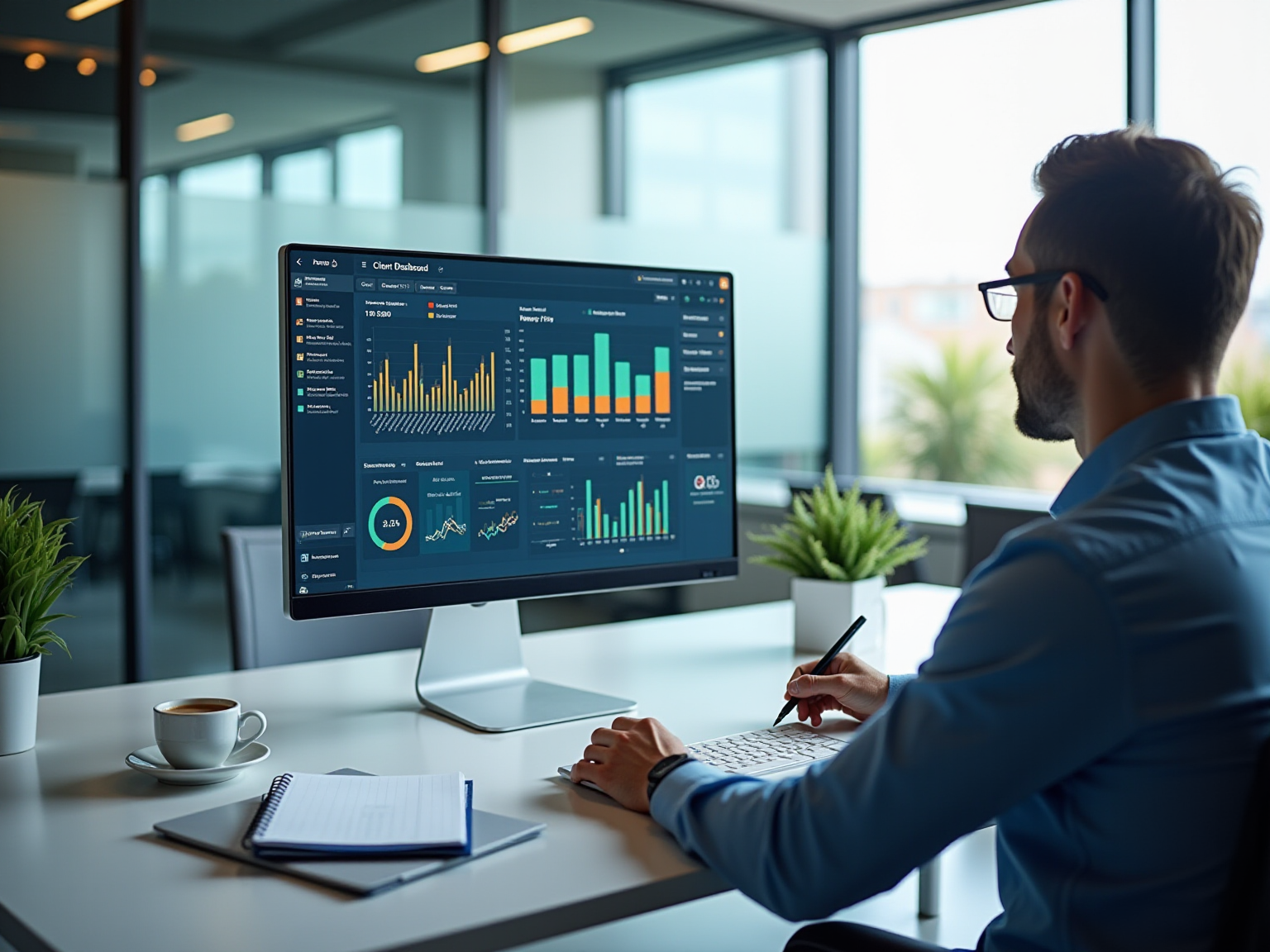Overview
The client dashboard serves as an indispensable tool that significantly enhances communication and efficiency within accounting practices. By centralising financial information and automating processes, it leads to improved customer engagement and informed decision-making. Firms leveraging client dashboards report remarkable reductions in response times and substantial time savings during the taxing tax season. Additionally, they experience heightened client satisfaction and gain competitive advantages in the marketplace. This compelling evidence underscores the necessity of adopting such innovative solutions to thrive in the accounting industry.
Key Highlights:
- Client dashboards are digital platforms that centralize financial information for customers and accountants, enhancing communication and data access.
- Integrating multiple data sources leads to improved decision-making and proactive engagement, with reported 50% reduction in response times and 288 hours saved during tax season.
- User-friendly features like automated reminders, secure file sharing, and real-time reporting promote trust and minimize follow-up time.
- The onboarding process is designed to be seamless, highlighting the importance of user interfaces in modern accounting practices.
- Effective client dashboards include real-time data visualization, customizable layouts, automated reporting, and robust security measures to protect sensitive information.
- Benefits of client dashboards include improved customer interaction, increased efficiency, enhanced decision-making, higher client satisfaction, competitive advantage, and scalability.
- Statistics show that firms using client dashboards experience a 40% increase in customer response rates and significant time savings for accountants.
Introduction
In the dynamic realm of accounting, the integration of client dashboards stands as a transformative force for firms aiming to elevate client engagement and operational efficiency. These digital interfaces not only grant clients real-time access to their financial data but also streamline communication between accountants and their clients. By consolidating vital information into an intuitive platform, client dashboards enable accountants to concentrate on strategic initiatives, significantly reducing the time spent on administrative tasks.
With statistics showcasing substantial enhancements in response times and overall productivity, the adoption of this technology has transitioned from being an option to an imperative for contemporary accounting practices. As firms navigate the intricate landscape of client relationships and the expectations of a digitally adept clientele, grasping the essential features and advantages of effective client dashboards is pivotal for maintaining a competitive edge in the industry.
Defining Client Dashboards: An Overview
A client dashboard serves as a pivotal digital platform that aggregates and displays vital information for both customers and financial professionals. This centralised client dashboard empowers users to access real-time data, monitor their financial metrics, and engage more effectively with their accountants. The client dashboard is designed to enhance communication and streamline information collection, simplifying the management of customer relationships while keeping users informed about their financial situations.
By integrating multiple data sources, the client dashboard offers a comprehensive overview of customer accounts, fostering improved decision-making and proactive involvement. Notably, there is a documented 50% reduction in response times and an impressive 288 hours saved during critical periods, such as tax season. Features like ‘Glasscubes’ automated reminders, secure file sharing, and real-time reporting capabilities ensure that responses are never misplaced, thereby promoting trust in customer interactions and minimising the time spent on follow-ups.
Moreover, the user-friendly onboarding process and open API facilitate seamless integration into existing systems, underscoring the growing importance of user interfaces in modern accounting practises. Industry leaders assert that the adoption of such technologies is crucial for accounting firms to meet the evolving expectations of younger generations, who are increasingly digital natives. Practical applications of consumer interfaces, such as the client dashboard, demonstrate their effectiveness in enhancing user interaction and optimising processes, making them an indispensable asset for financial professionals.

The Importance of Client Dashboards for Accountants
Customer interfaces are indispensable for financial professionals, significantly enhancing both customer engagement and operational efficiency. By granting customers direct access to their financial information, these interfaces minimise the time professionals dedicate to follow-ups and inquiries, leading to improved customer satisfaction. This newfound efficiency empowers financial professionals to redirect their focus toward higher-value tasks, such as strategic planning and advisory services.
Moreover, visual displays allow accountants to identify patterns and anomalies in customer data, facilitating timely guidance and support. In today’s competitive landscape, leveraging customer interfaces not only streamlines operations but also distinguishes firms by demonstrating a commitment to transparency and proactive service.
Statistics indicate that organisations utilising such tools experience a remarkable 50% reduction in response times, with users like Sophie Montgomery of TaxAssist Accountants reporting an impressive savings of 288 hours in a single tax season. Furthermore, Glasscubes enhances this experience through features like automated reminders and real-time progress tracking, ensuring that all communications remain organised and readily accessible.
The case study titled ‘The Cost of Poor Customer Engagement’ underscores that neglecting to invest in customer engagement can result in substantial revenue losses, highlighting the necessity of a robust engagement strategy. Additionally, with 79% of consumers expecting brands to respond within a day on social media, the significance of customer interfaces in fostering effective communication and engagement becomes increasingly apparent.
As we advance through 2025, the relevance of these visual tools continues to grow, making them essential for accountants striving to enhance their service offerings and operational processes.

Key Features of Effective Client Dashboards
Efficient user interfaces encompass essential attributes that significantly enhance usability and functionality.
- Real-Time Data Visualisation: Client dashboards must present information in real-time, enabling users to continuously monitor their financial performance and make informed decisions swiftly.
- Customisable Layouts: Users should possess the flexibility to modify the interface, showcasing the most relevant metrics and key performance indicators (KPIs) tailored to their needs, thereby enriching the overall user experience.
- Automated Reporting: The capacity to generate reports automatically not only conserves time but also ensures that users receive timely updates on their financial status, fostering proactive management.
- User-Friendly Interface: A straightforward and intuitive layout is paramount, allowing users to navigate the interface effortlessly without extensive training. Glasscubes provides an effortless onboarding experience with no training required and personalised setup assistance, ensuring maximum engagement.
- Effective client dashboards should seamlessly integrate with various accounting software and tools, offering a comprehensive view of customer data and streamlining workflows.
- Secure Access: Given the sensitive nature of financial data, robust security features are crucial to protect user information and ensure compliance with regulations, thereby building trust. The platform offers a secure, GDPR-compliant environment that enhances the functionality of client dashboards.
The automated reminder feature is particularly significant, empowering individuals to send an unlimited number of reminders on a customisable schedule. This guarantees timely communication and underscores urgency in meeting deadlines. Statistics reveal that companies utilising advanced display functionalities, like those provided by other vendors, experience a 40% increase in customer response rates and a 50% reduction in response times, emphasising the efficiency of these tools in enhancing customer interaction. User testimonials highlight substantial time savings, with one accountant reporting an impressive 288 hours saved in a single tax season, thanks to the streamlined processes facilitated by Glasscubes. These insights illustrate the transformative impact of efficient user interfaces within the accounting sector.

Benefits of Implementing Client Dashboards in Accounting
Implementing client dashboards in accounting practises presents a multitude of significant benefits:
-
Improved Customer Interaction: Providing customers with easy access to their financial information enables firms to cultivate stronger relationships and enhance communication, resulting in a more collaborative atmosphere. As noted by Steve, an audit manager, clients appreciate the clarity of accessing the platform to see precisely what information they need to provide, thereby fostering a more engaged relationship.
-
Increased Efficiency: Automatising data collection and reporting significantly reduces the time accountants dedicate to administrative tasks. This transition allows them to focus on strategic initiatives, ultimately boosting productivity. Users of the platform have reported saving an impressive 288 hours in a single tax season, underscoring the tangible benefits of such technology. Steve’s experience illustrates this, as he found that customers uploaded information more swiftly through the platform than through traditional email methods, streamlining the audit process.
-
Enhanced Decision-Making: The real-time insights offered by automated reporting capabilities empower both accountants and customers to make informed decisions promptly, enabling them to adapt to shifts in financial situations efficiently. The option to set automatic reminders for customers to upload information further enriches this decision-making process.
-
Higher Client Satisfaction: Clients prioritise transparency and timely access to information, which cultivates loyalty and boosts retention rates. Companies leveraging this tool have experienced a 40% increase in customer response rates, highlighting its positive impact on customer relationships. Steve’s testimonial emphasises that users value having a single secure workspace for all their information and inquiries, significantly enhancing their satisfaction.
-
Competitive Advantage: Organisations that utilise customer interfaces, particularly through platforms like these tools, differentiate themselves in the market, showcasing their commitment to innovation and exceptional service. This distinction is crucial in a competitive environment where automation is becoming indispensable for business success. As Brian Sanders aptly states, “Automation enhances, not replaces, the role of accountants.”
-
Scalability: As organisations expand, Glasscubes interfaces can seamlessly adapt to accommodate additional users and data sources, ensuring that practises remain efficient and effective. This flexibility is essential for sustaining growth and upholding high service standards.
As automation continues to evolve, the integration of client dashboards will be crucial in optimising workflows and enhancing overall client engagement.
Conclusion
The integration of client dashboards into accounting practices is not merely a trend; it has become a fundamental necessity for firms that aspire to thrive in a competitive environment. By providing real-time access to financial data, these dashboards enhance client engagement, streamline communication, and significantly improve operational efficiency. Features such as automated reporting and customizable layouts allow accountants to focus on strategic planning rather than administrative tasks, ultimately leading to superior service delivery and heightened client satisfaction.
The advantages of client dashboards extend well beyond mere convenience. They empower accountants to make informed decisions swiftly, adapt to changing circumstances, and cultivate stronger relationships with clients. As firms increasingly embrace these technologies, the statistics are compelling: notable reductions in response times and impressive time savings during peak periods, such as tax season, underscore the transformative impact of these tools. In a landscape where transparency and responsiveness are paramount, client dashboards emerge as a vital resource for enhancing engagement and securing a competitive edge.
Looking ahead, the significance of client dashboards will only continue to escalate. As the accounting landscape evolves, adopting these digital solutions will be crucial for firms aiming to meet the expectations of a digitally savvy clientele. By investing in client dashboards, accounting practices not only optimize their workflows but also position themselves as leaders in client service, paving the way for future success.
